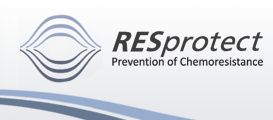|
Page 3 of 12
Materials and Method
Chemicals.
DMBA, MMC, MTX, and DOX were from Sigma (Deisenhofen, Germany). MXA, cisplatin, glufosfamide, and DOX for in vivo tests were from Asta Medica (Frankfurt am Main, Germany). BVDU (RP101) was from RESprotect and Berlin-Chemie (Berlin, Germany). RNase was from Boehringer (Mannheim, Germany), and restriction enzymes were from New England Biolabs (Schwabach, Germany). All of the other chemicals were purchased from Sigma and Roth (Karlsruhe, Germany).
3T6 Cell Culture and Development of Methotrexate Resistance.
Swiss albino mouse fibroblasts, 3T6, were grown in DMEM supplemented with 10% fetal bovine serum, penicillin, and streptomycin (Biochrom, Berlin, Germany). Cells (2.8 x 105) were plated into 9 T25-flasks with MTX, and 9 T25-flasks with MTX and 30 µM BVDU. As soon as cells approached confluency, they were trypsinized and replated at the next higher drug concentration. The MTX concentration was increased 1.5-fold at 1-week intervals for 60 days starting with 44 nM MTX. The number of living cells was determined using the Cell Counter and Analyser System CASY TT (Schärfe System GmbH, Reutlingen, Germany). Cell counting and cell volume determination were hereby based on the displacement of conductive electrolyte by dielectric cells. The signals generated by the cells suspended in an electrolyte were evaluated by pulse area analysis. The pulse area of the signal was strictly proportional to the volume of the particle generating the signal. In dead cells, the integrity of the cell membrane is lost. This loss increased the conductivity and reduced the pulse area of the electric signal. Thus, to exclude debris and dead cells, only particles with a size of >7.5 µm were counted as cells.
Treatment of AH13r Sarcoma Cells in Culture.
AH13r cells, a subline of the rat Yoshida sarcoma, were obtained from the Cell and Tumor Bank of the West German Cancer Center, University Essen, Medical School (Essen, Germany). Cells were grown in DMEM (FG 0415; Biochrom AG, Berlin, Germany) supplemented with 10% (v/v) heat-inactivated fetal bovine serum, 100 units/ml penicillin, and 100 µg/ml streptomycin in a humidified atmosphere containing 5% CO2 at 37°C. Logarithmically growing cells were seeded at a density of 100,000 cells/ml and incubated with different cytostatic drugs in combination with or without BVDU. After 2–4 days (unless otherwise indicated), cells were counted using the Cell Counter and Analyser System CASY TT (Schärfe System GmbH), and serially passaged.
HOPI Double Staining.
Apoptosis was assayed by HOPI staining as described by Grusch et al.. Viable, apoptotic, and necrotic cells were counted. The Hoechst 33258 dye stains the nuclei of all cells. Nuclear changes associated with apoptosis, such as chromatin condensation and nuclear fragmentation, can be readily monitored and quantified. Propidium iodide uptake indicates loss of membrane integrity characteristic for necrotic and late apoptotic cells. The selective uptake of the two dyes allows to distinguish between apoptotic and necrotic cell death. Necrosis is characterized in this system by nuclear propidium iodide uptake into cells without chromatin condensation or nuclear fragmentation.
|





